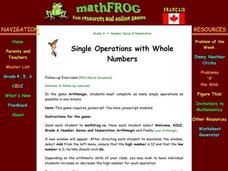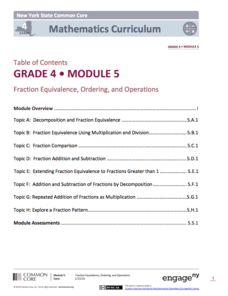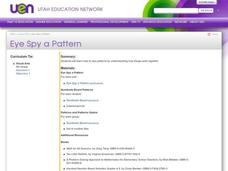Curated OER
Fractions of Quantities
What is 1/4 of 36? The class will work through six examples and 4 problems to better understand the relationship between fraction and quantity. The first six example show how a whole is broken into equal parts and is represented as a...
Virginia Department of Education
Simplifying Square Roots of Whole Numbers
Simplify your life by using a resource on simplifying square roots. Pupils review square roots and calculate values of given radical expressions using a calculator. The instructional activity concludes by having them consider the results...
Curated OER
Multiplication of Whole Numbers
For this math worksheet, students find the answers to the multiplication problems that are related to the operation with the four digits.
Scholastic
Study Jams! Number Patterns
Finding patterns is an essential skill for mathematicians of all ages. Follow along with Zoe as she walks step-by-step through the process of identifying and completing number patterns. Work through the Try It! problems as a whole class...
Curated OER
Know Your Fractions
In this know your fractions worksheet, students practice drawing a line from the portion of eight shapes to the appropriate fraction or whole number.
Curated OER
Finding PI
Students select and use appropriate operations, methods and tools to compute or estimate using whole numbers. They develop and use formulas for determining the circumference and area of circles. Students determine and describe the...
Curated OER
To Be (Half) Or Not To Be (Half)
First graders demonstrate various ways to represent and verify a whole or set separated in two, three, or four equal parts. Using interlocking cubes, Students model a part of a whole or a part of a set. They use appropriate tools and...
Curated OER
Divide and Conquer
Seventh graders analyze responses to different types of problems. Using pictures and diagrams, they explore and model the division of fractions. Students examine situations that call for division whether with the whole numbers or with...
Curated OER
Number and Operations: Webbing Our Way Through Numbers
Second graders explore estimation and place value. In this place value lesson, 2nd graders estimate and construct numbers while working with spider activities. Students use addition and subtraction to compare estimates. Resources and...
Curated OER
Integers
In this integers activity, 8th graders solve 10 various types of problems to include rewriting each statement using the convention for Positive integers and then calculate their answer. They also rewrite each statements without the...
Curated OER
Number Sense and Operations
In this number sense and operations worksheet, 7th graders solve 15 different types of problems that include estimation and expanded notation. First, they simplify various equations by following the order of operations. Then, students...
Curated OER
Multiplication Two Digit by Three Digit Numbers
In this multiplication worksheet, learners multiply two digit numbers by three digit numbers. Students complete 30 multiplication problems.
Curated OER
Properties of Operations
For this algebra worksheet, students identify different properties of integers and their operations. There are 30 questions with an answer key.
Curated OER
Single Operations with Whole Numbers
Sixth graders play the game ArithmAttack, they complete as many single operations as possible in 60 seconds. They go to the Mathfrog website and select ArithmAttack. Students select their high number as 12 and their low number as 0. They...
Curated OER
Real Numbers in the Real World
Delve into the concept of operating on the set of real numbers! In this operating with the set of real numbers lesson, pupils perform order of operations on the set of real numbers using a calculator.
Curated OER
Unit II - Version 6.0 - Worksheet 1 - Fractions
In this fraction worksheet, students determine the number of parts in a whole. They add and divide fractions. This one-page worksheet contains 11 problems.
Virginia Department of Education
Using Order of Operations and Exploring Properties
If you need some creative ways to teach the order of operations, use a series of activities that focus on properties. Each lesson uses different materials and works as a stand-alone activity, or can build upon the concepts of the last...
Charleston School District
Estimating Values of Expressions
You can't evaluate an irrational root expression without a calculator—or can you? Scholars estimate the value of roots within an expression to approximate the value of the expression. Expressions include a mix of square roots and whole...
Little 10 Robot
Operation Math Code Squad
Your mission, if you decide to accept it, is math skills practice. In this app, Mission Impossible meets basic number operation skills, and your students are the secret agents.
Los Angeles County Office of Education
Assessment For The California Mathematics Standards Grade 4
Have scholars show what they know with a 20-page assessment aligned to the California State Standards. The test covers concepts such as large and whole numbers, all four mathematical operations, fractions, decimals, geometric figures,...
Virginia Department of Education
Integers: Addition and Subtraction
Young mathematicians construct their own understanding of integers with an inquiry-based math lesson. Using colored chips to represent positive and negative numbers, children model a series of addition and subtraction problems as...
EngageNY
Fraction Equivalence, Ordering, and Operations
Need a unit to teach fractions to fourth graders? Look no further than this well-developed and thorough set of lessons that takes teachers through all steps of planning, implementing, and assessing their lessons. Divided into eight...
Curated OER
Estimating Sums and Differences
In this estimation of sums and differences worksheet, 7th graders solve 20 different problems that are related to estimation of numbers. They add or subtract each problem as shown. Then, students estimate the sums and differences for...
Curated OER
Eye Spy a Pattern
Fifth graders examine how to see patterns by showing how things work together. They identify, analyze and determine a rule for predicting and extending numberical patterns involving operations of whole numbers, decimals and fractions.

























